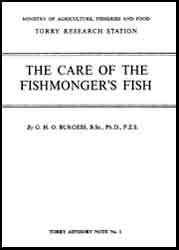
Contents Index

Accompanying Notes
Table of Contents
MINISTRY OF AGRICULTURE, FISHERIES AND FOOD
TORRY RESEARCH STATION
By G.H.O. BURGESS, B.Sc., Ph.D., F.Z.S.
TORRY ADVISORY NOTE No. 1
The Torry Research Station, with its sub-station in Hull, the Humber Laboratory, carries out research into problems of fish handling, preservation and distribution. It is part of the Ministry of Agriculture, Fisheries and Food.
As every fishmonger knows to his cost, fish is a highly perishable foodstuff that must be handled with the greatest care and speed if it is to reach the consumer in good condition. This pamphlet has been written in order to tell you, the fishmonger, the scientific causes of deterioration in fish, and to recommend ways in which you can do that little bit more to retain the freshness of fish while it is in your care
Crown copyright material is reproduced with the permission of the Controller of Her Majesty's Stationery Office.
This electronic document has been scanned using optical character recognition (OCR) software and careful manual recorrection. Even if the quality of digitalisation is high, the FAO declines all responsibility for any discrepancies that may exist between the present document and its original printed version.
Emphasises the need for care in handling fish from catching
to sale because fish is a highly perishable foodstuff. Explains bacterial spoilage
in simple terms, describes how chilling reduces the rate of spoilage, summarises
the advantages of using ice for chilling, and notes the consequences of poor
handling practice. In general, the bacteria that cause spoilage in fish are
described as psychrophilic or psychrotrophic, and can grow slowly below 0°
C, even down to about - 10° C. In this Note and others,
end of shelf-life is regarded as the point of condemnation as unfit to eat.
For cod (Gadus morhua) this is equivalent to 14 to 16 days of storage,
chilled in melting ice. Briefly mentions the need for good hygiene and regular
cleaning with reference to Notes 23 and 45. Measurements are given
in British units; Note 40 gives conversion factors
to SI units. Read in conjunction with Notes 12, 14, 91
and 92.
(FAO in partnership with Support unit for International Fisheries and Aquatic Research, SIFAR, 2001).
Why fish goes bad
Where the bacteria come from
The effect of temperature on
bacteria
The control of temperature
The advantages of ice and
how to use it
What you can do
Contents Index